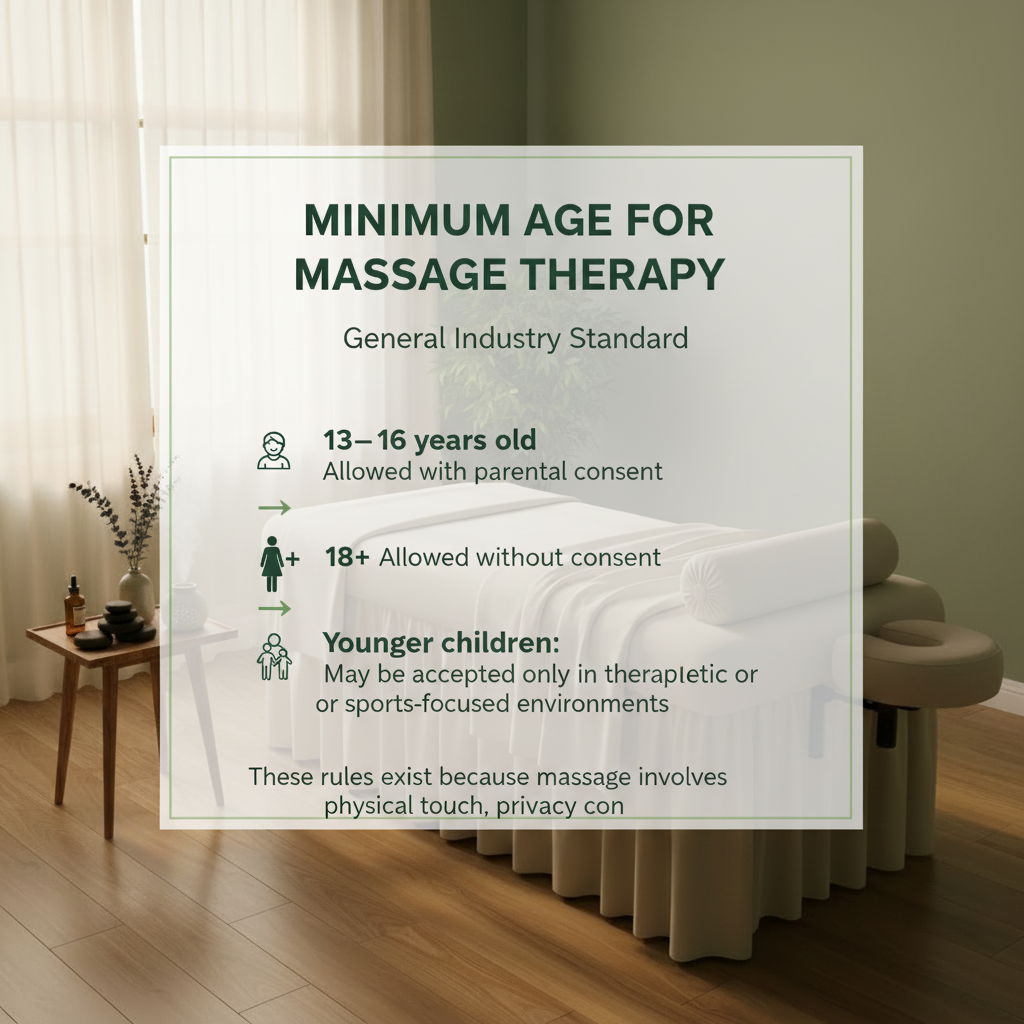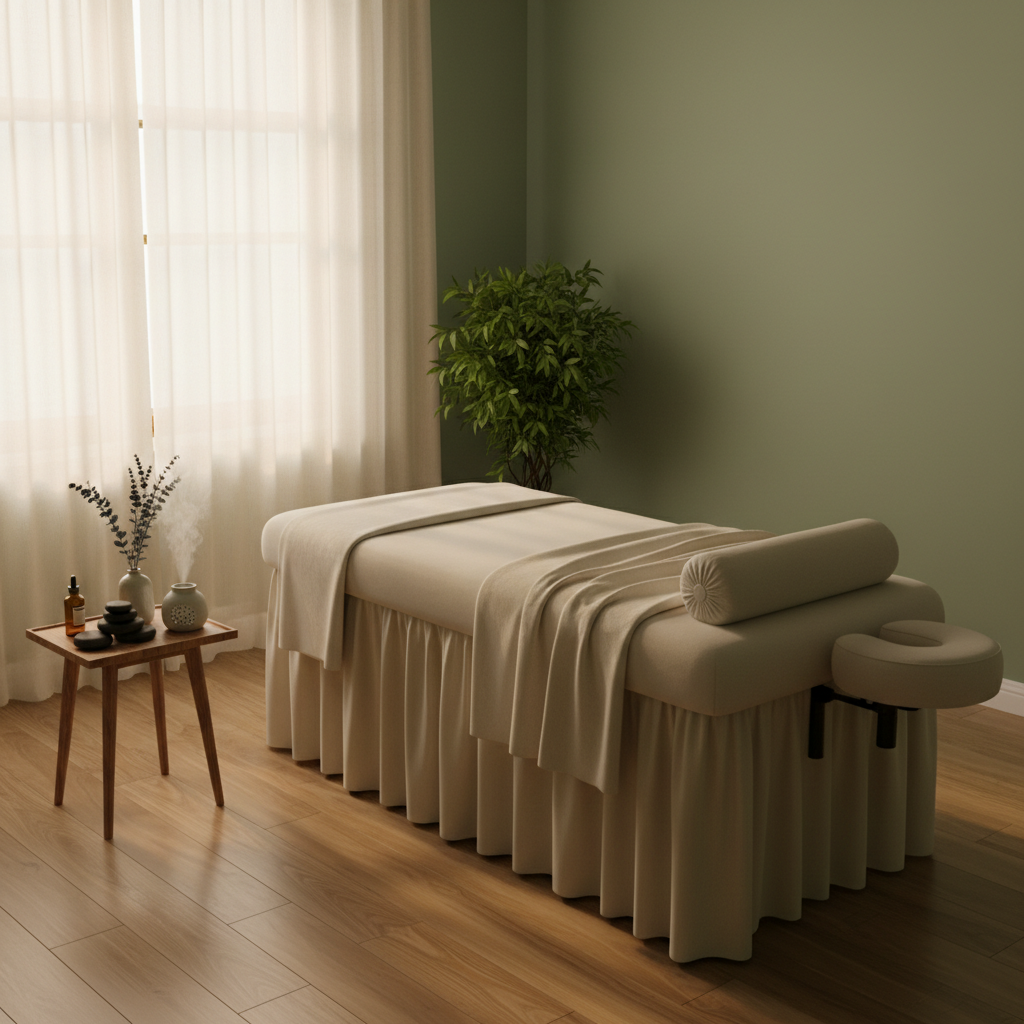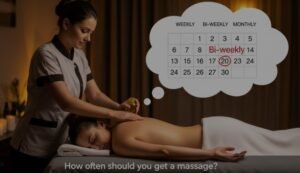Massage therapy has become more popular than ever not only for adults, but also for teens, student athletes, and younger wellness-focused clients. As parents explore natural ways to help their children manage stress, sports tightness, posture problems, or anxiety, it’s completely normal to wonder: How old do you have to be to get a massage?
The answer isn’t as simple as a single number. Age rules vary depending on the spa, the therapist, the state or province, and even the type of massage you’re booking. Some places welcome younger teens with parental consent, while others have strict minimum age rules.
This complete guide breaks everything down age limits, consent requirements, safe massage types for minors, legal considerations, and how to prepare your child or teen for their first session.
Let’s get into it.
Understanding Massage Age Requirements: The Short Answer
Minimum Age in Most Places
In most regions, there is no government-mandated minimum age for massage therapy. Instead, spas and clinics set their own policies.
The general industry standard is:
- 13–16 years old → Allowed with parental consent
- 18+ → Allowed without consent
- Younger children → May be accepted only in therapeutic or sports-focused environments
These rules exist because massage involves physical touch, privacy considerations, and emotional maturity. Therapists must also follow strict safety and liability guidelines.

Why Rules Differ Among Spas
Each spa sets its own rules based on:
- Insurance limitations – Some liability policies restrict treating minors under a certain age.
- Therapist comfort level and training – Not all therapists are trained to work with children or teens.
- Environment – A calm spa environment may not be designed for young minors.
This is why it’s always a good idea to call ahead.
How Old Do You Have to Be to Get a Massage in Different Settings?
Day Spas & Wellness Centers
Most day spas follow these guidelines:
- Accept clients 13–16 with parental consent
- Require a parent to remain on-site
- Sometimes require a parent to be in the treatment room
Spas also tend to offer more gentle massage types for minors.
Medical or Sports Massage Clinics
Sports massage clinics commonly see minor athletes for muscle recovery.
Typical policies include:
- Accepting clients as young as 10–17 years old
- Written consent required
- Parent must stay on-site or inside the room
- Sessions are structured, guided, and professional
This environment is usually the most accommodating for younger clients.
Hotel & Resort Spas
These spas usually have the strictest age rules, often due to insurance:
- Many require guests to be 16+
- Some allow junior spa treatments (often 6–12 years old), but these are short, gentle, and highly supervised
- Full-body massage for younger teens is less common
Always check guidelines when booking during travel.
When Parental Consent Is Required
Common Consent Policies
Most places require:
- Written consent forms
- A parent or guardian to stay in the treatment room
- Approval of draping, clothing, and areas to work on
- Agreement on session length and type of massage
Even if the spa doesn’t require being in the room, many parents choose to stay nearby.
What Parents Should Know Before Approving a Massage
Before saying yes to any massage for a minor:
- Choose a licensed massage therapist (LMT)
- Ask whether they’ve worked with minors before
- Clarify what areas will not be worked on (such as chest, glutes, inner thighs)
- Communicate any injuries, sensitivities, or discomforts
A good therapist will always prioritize safety and comfort.
What Types of Massage Are Safe for Minors?
Recommended Massages for Teens
These options are gentle, relaxing, and appropriate for most minors:
- Swedish massage (light to moderate pressure)
- Sports massage for athletes
- Hand/foot reflexology
- Scalp or neck massage
- Back, shoulder & upper body sessions
Massages Usually Not Recommended for Minors
Certain modalities may be too intense or inappropriate:
- Deep tissue
- Hot stone
- Lymphatic drainage without medical direction
- Any massage requiring full disrobing unless properly supervised
When in doubt, choose lighter, shorter sessions.
Special Programs for Kids & Teens
Some spas offer:
- Teen spa menus
- 20–30 minute sessions
- Relaxation-based treatments instead of full-body work
These programs are customized to age, attention span, and comfort level.
Legal & Safety Considerations You Should Know
State or Regional Licensing Rules
Most places do not legally define a minimum age. Instead:
- Licensing boards regulate therapists
- Spas set internal rules
- Policies vary widely by region
This is why the answer changes from one location to another.
What a Minor Can Expect During a Session
To ensure safety and comfort:
- Draping covers all non-treated areas
- Therapists check in frequently
- Communication stays professional at all times
- Minors can request a male or female therapist
Parents and children can also request pressure adjustments or stop the session at any moment.
Privacy Standards for Clients Under 18
Depending on the spa:
- A parent may be required to be in the room
- Some allow parents to stay outside, depending on age
- Therapists follow strict boundaries and professional ethics
Transparency is always a priority when working with minors.
Benefits of Massage for Teens and Younger Clients
Physical Benefits
Massage can help:
- Reduce tightness in student athletes
- Improve posture caused by heavy backpacks or screens
- Relieve headaches and muscle tension
- Improve sleep quality
Mental and Emotional Benefits
Massage offers powerful non-medical support for:
- Stress and emotional overload
- Focus and academic performance
- Mild anxiety
- Sensory calming in children who respond well to gentle touch
It’s a natural way to help teens manage modern-day stressors.
Alternatives for Children Too Young for Professional Massage
Safe At-Home Options
Parents can try:
- Light, gentle parent-guided massages
- Foam rollers or massage balls
- Warm baths or compresses
- Relaxation time before bed
These help younger children relax safely.
Child-Friendly Wellness Activities
Great non-massage alternatives include:
- Kids’ yoga
- Stretching routines
- Breathing exercises
- Sensory toys for calming
Pediatric Massage Therapists
A pediatric massage therapist:
- Has special training in child anatomy and communication
- Works with infants, children, and teens
- Provides gentler, shorter, age-appropriate sessions
This is an ideal option for very young children or kids with special needs.
How to Prepare Your Teen or Child for Their First Massage
What to Discuss Before Arriving
Talk about:
- What a massage is like
- Clothing and draping
- Boundaries (areas they want to avoid)
- Speaking up if anything feels uncomfortable
This helps reduce stress and improve the experience.
Questions to Ask the Spa or Therapist
- Do you accept minors?
- What age requires parental presence?
- Which services are available for clients under 18?
- Do therapists have experience with teens or children?
Clear expectations create a safe and positive experience.
FAQ’s
Can a 12-year-old get a massage?
Yes, in many sports or clinical settings, but parental consent is required. Some spas may decline due to policy.
Can a 17-year-old get a massage alone?
Some spas allow it, but many still require a parent to sign paperwork or stay on-site.
Do minors have to keep clothes on?
Most places allow minors to stay fully clothed, especially during sports or relaxation massages.
What if my child feels uncomfortable during the session?
They or you can stop the session immediately. Comfort and safety always come first.
Are there special waivers for athletes?
Yes. Sports clinics often have customized forms for minors participating in athletic programs.
Conclusion
So, how old do you have to be to get a massage?
For most teens, the answer is 13–16 with parental consent, while adults 18+ can book freely. Age rules vary widely depending on the spa, environment, and local regulations, so checking in advance is always the best approach.
Massage therapy can be incredibly beneficial for teens, from reducing sports tension to easing stress and improving sleep. As long as parents stay involved, choose reputable therapists, and communicate with the spa, massage can be a safe and positive experience for younger clients.
If you’re unsure of your local rules, contact a licensed massage therapist or spa to confirm age requirements before booking.







